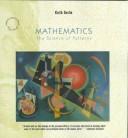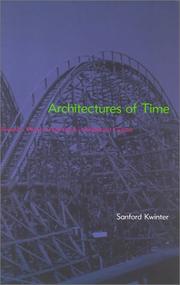| Listing 1 - 3 of 3 |
Sort by
|

ISBN: 0716750473 9780716750475 0716760223 9780716760221 Year: 1994 Publisher: New York, NY ; Oxford : W. H. Freeman,
Abstract | Keywords | Export | Availability | Bookmark
 Loading...
Loading...Choose an application
- Reference Manager
- EndNote
- RefWorks (Direct export to RefWorks)
With this fascinating volume, Keith Devlin proves that the guiding principles of some of the most mysterious mathematical topics can be made comprehensible. Writing with an elegant lucidity, Devlin shows just why the definition of mathematics as "working with numbers" has been out of date for nearly 2,500 years. And he demonstrates that far from being too abstract to matter, mathematics is instead an essential and uniquely human endeavor, one that helps us understand the universe and ourselves." "In this century alone, there has been a veritable explosion of mathematical activity. A body of knowledge that in 1900 might have filled 80 volumes now would require nearly 100,000. Fields such as algebra and topology have grown tremendously, while complexity theory, dynamical systems theory, and other new areas have developed. And in the last two decades, a common thread running through the many facets of mathematics has been recognized: mathematicians of all kinds now see their work as the study of patterns - real or imagined, visual or mental, arising from the natural world or from within the human mind." "Devlin uses this basic definition as his central theme, revealing the search for patterns that drives the mathematics of counting (natural numbers), reasoning (language and logic), motion (calculus), shape (geometry, tilings), and position (topology, knots, symmetry). Interweaving historical highlights and current developments, and using a minimum of formulas, he lets readers see into the kind of reasoning that allows mathematicians to create and explore arcane subjects. And he makes clear the many ways mathematics informs our perceptions of reality - both the physical, biological, and social worlds without, and the realm of ideas and thoughts within.

ISBN: 0262611813 0262112604 9780262611817 Year: 2002 Publisher: Cambridge, Mass. London MIT
Abstract | Keywords | Export | Availability | Bookmark
 Loading...
Loading...Choose an application
- Reference Manager
- EndNote
- RefWorks (Direct export to RefWorks)
An exploration of twentieth-century conceptions of time and their relation to artistic form. In Architectures of Time, Sanford Kwinter offers a critical guide to the modern history of time and to the interplay between the physical sciences and the arts. Tracing the transformation of twentieth-century epistemology to the rise of thermodynamics and statistical mechanics, Kwinter explains how the demise of the concept of absolute time, and of the classical notion of space as a fixed background against which things occur, led to field theory and a physics of the "event." He suggests that the closed, controlled, and mechanical world of physics gave way to the approximate, active, and qualitative world of biology as a model of both scientific and metaphysical explanation.Kwinter examines theory of time and space in Einstein's theories of relativity and shows how these ideas were reflected in the writings of the sculptor Umberto Boccioni, the town planning schema of the Futurist architect Antonio Sant'Elia, the philosophy of Henri Bergson, and the writings of Franz Kafka. He argues that the writings of Boccioni and the visionary architecture of Sant'Elia represent the earliest and most profound deployments of the concepts of field and event. In discussing Kafka's work, he moves away from the thermodynamic model in favor of the closely related one of Bergsonian duree, or virtuality. He argues that Kafka's work manifests a coherent cosmology that can be understood only in relation to the constant temporal flux that underlies it.
72.01 --- Architectuurtheorie over de Moderne Beweging --- Architectuur en wiskunde architectuur en wetenschap --- Architectuur 1ste h. 20ste eeuw --- Modernisme --- Architectuur theorie, filosofie, esthetica --- Modern Movement (Architecture) --- Modernism (Architecture) --- Modernist architecture --- Modern movement (Architecture). --- Modern movement (Architecture) --- Architecture, Modern --- Mouvement moderne (Architecture) --- Architecture --- International style (Architecture) --- Architectuur ; 1ste h. 20ste eeuw --- Architectuur en wiskunde ; architectuur en wetenschap --- Architectuurtheorie ; over de Moderne Beweging --- Architectuur ; theorie, filosofie, esthetica
Book
ISBN: 9070157810 Year: 1989 Publisher: Maastricht Wetenschappelijke bibliotheek
Abstract | Keywords | Export | Availability | Bookmark
 Loading...
Loading...Choose an application
- Reference Manager
- EndNote
- RefWorks (Direct export to RefWorks)
Wiskunde geschiedenis --- Wiskunde : maatschappelijke relevantie --- 511 --- 510 --- 51-73 --- Architectuur ; in de natuur ; zuinigheidsbeginsel --- Architectuur en wiskunde ; architectuur en wetenschap --- Wiskunde ; variatierekening ; optimale vormberekening --- Mathematics--?-73 --- Architectuur ; proportie, symmetrie, harmonie --- Architectonische vormgeving --- Natuurlijke vormen --- out of print --- Architectonische vormgeving. --- Natuurlijke vormen. --- 51-73 Mathematics--?-73 --- Wiskunde ; geschiedenis --- natuur --- structuren --- 53 --- 54 --- $?$90/05 --- 72.013 --- Nature protection --- Science --- Mathematics
| Listing 1 - 3 of 3 |
Sort by
|

 Search
Search Feedback
Feedback About
About Help
Help News
News